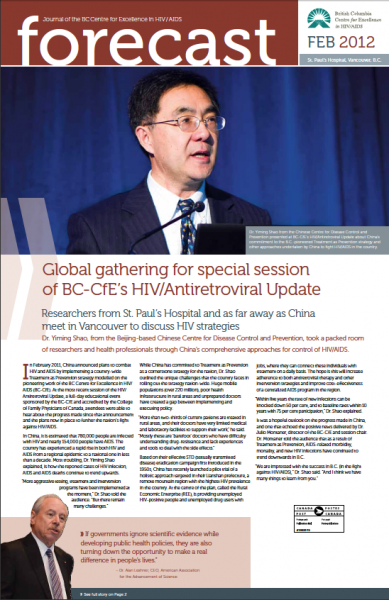Global gathering for special session of BC-CfE’s HIV/Antiretroviral Update
Researchers from St. Paul’s Hospital and as far away as China meet in Vancouver to discuss HIV strategies
 Dr. Yiming Shao, from the Beijing-based Chinese Centre for Disease Control and Prevention, took a packed room of researchers and health professionals through China’s comprehensive approaches for control of HIV/AIDS.
Dr. Yiming Shao, from the Beijing-based Chinese Centre for Disease Control and Prevention, took a packed room of researchers and health professionals through China’s comprehensive approaches for control of HIV/AIDS.
In February 2011, China announced plans to combat HIV and AIDS by implementing a country-wide Treatment as Prevention strategy modelled on the pioneering work of the BC Centre for Excellence in HIV/AIDS (BC-CfE). At the most recent session of the HIV/Antiretroviral Update, a full-day educational event sponsored by the BC-CfE and accredited by the College of Family Physicians of Canada, attendees were able to hear about the progress made since that announcement and the plans now in place to further the nation’s fight against HIV/AIDS.
In China, it is estimated that 780,000 people are infected with HIV and nearly 154,000 people have AIDS. The country has experienced a rapid rise in both HIV and AIDS from a regional epidemic to a national one in less than a decade. Most troubling, Dr. Yiming Shao explained, is how the reported cases of HIV infection, AIDS and AIDS deaths continue to trend upwards.
“More aggressive testing, treatment and intervention programs have been implemented at the moment,” Dr. Shao told the audience. “But there remain many challenges.”
While China has committed to Treatment as Prevention as a cornerstone strategy for the nation, Dr. Shao outlined the unique challenges that the country faces in rolling out the strategy nation-wide. Huge mobile populations (over 220 million), poor health infrastructure in rural areas and unprepared doctors have created a gap between implementing and executing policy.
“More than two-thirds of current patients are treated in rural areas, and their doctors have very limited medical and laboratory facilities to support their work,” he said. “Mostly these are ‘barefoot’ doctors who have difficulty understanding drug-resistance and lack experiences and tools to deal with the side effects.”
Based on their effective STD (sexually transmitted disease) eradication campaign first introduced in the 1950s, China has recently launched a pilot trial of a holistic approach targeted in their Lianshan prefecture, a remote mountain region with the highest HIV prevalence in the country. At the centre of the plan, called the Rural Economic Enterprise (REE), is providing unemployed HIV-positive people and unemployed drug users with jobs, where they can connect these individuals with treatment on a daily basis. The hope is this will increase adherence to both antiretroviral therapy and other intervention strategies and improve cost-effectiveness of a centralized AIDS program in the region.
“Within five years the rate of new infections can be knocked down 50 per cent, and to baseline rates within 10 years with 75 per cent participation,” Dr. Shao explained.
It was a hopeful outlook on the progress made in China, and one that echoed the positive news delivered by Dr. Julio Montaner, director of the BC-CfE and session chair. Dr. Montaner told the audience that as a result of Treatment as Prevention, AIDS-related morbidity, mortality, and new HIV infections have continued to trend downwards in B.C.
“We are impressed with the success in B.C. [in the fight against HIV/AIDS],” Dr. Shao said. “And I think we have many things to learn from you.”
